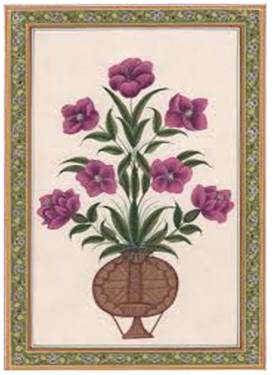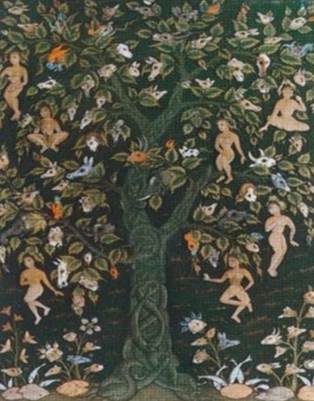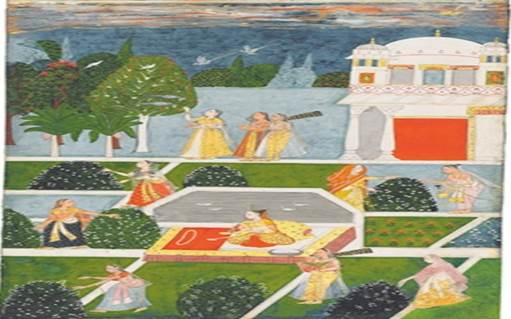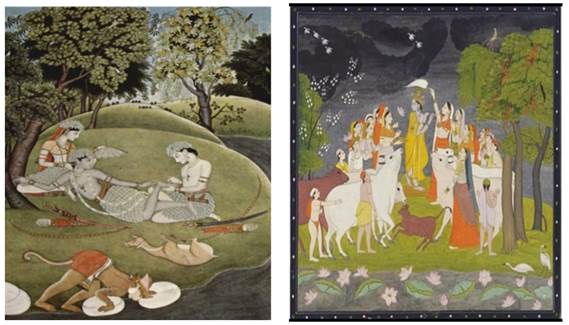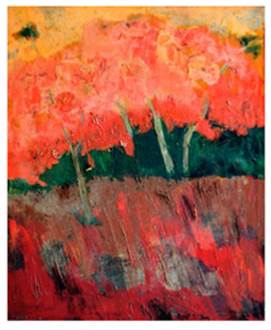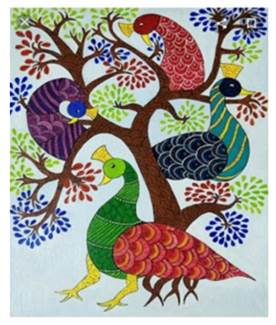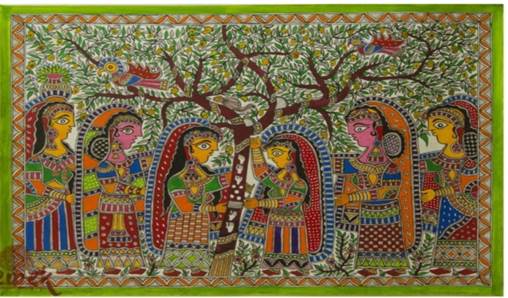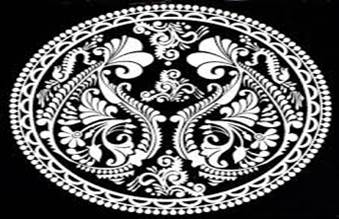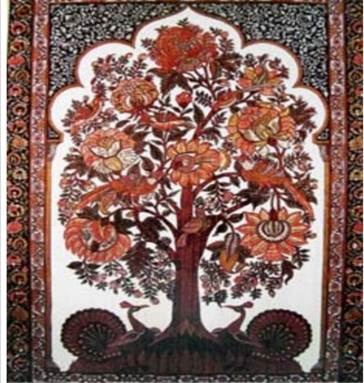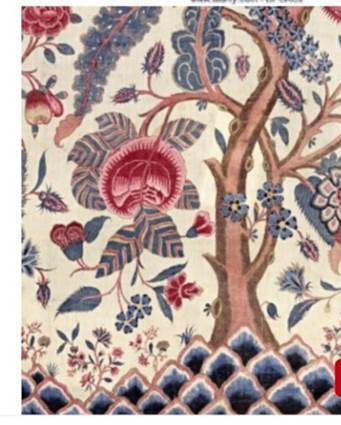ShodhKosh: Journal of Visual and Performing ArtsISSN (Online): 2582-7472
|
|
VEGETATION IN INDIAN ART1 HOD, Drawing and Painting Department, Maharani Lakshmi Bai Government Girls Pg Auto College, Bhopal, M.P, India |
|
||
|
|
|||
|
Received 06 May 2020 Accepted 16 June 2020 Published 27 June 2020 Corresponding Author Dr. Anjali Pandey, anjali_pandey11@yahoo.com DOI 10.29121/shodhkosh.v1.i1.2020.8 Funding: This research received
no specific grant from any funding agency in the public, commercial, or
not-for-profit sectors. Copyright: © 2020 The Author(s).
This is an open access article distributed under the terms of the Creative
Commons Attribution License, which permits unrestricted use, distribution,
and reproduction in any medium, provided the original author and source are
credited.
|
ABSTRACT |
|
|
|
Indian art is a vivid presentation of various forms of nature. In many
ancient cultures trees are treated with acclaim and affection but in India treated
with reverence and love. The concept of tree, as a symbol of life, of
eternity and resumption is as old as humankind. The environmentalists
evaluate their importance for the world's ecosystem as they are used in
numerous ways in everyday life, but their aspect is that they are the symbol
of divinity of nature with beauty and cultural values. Nature with its qualities helps the creatures in their survival. The
beauty of nature can be perceived in its utility and man can pay his
attributes with the awareness towards the protection of nature. |
|
||
|
Keywords: Primitive Fertility, Animism, Stylized Form 1. INTRODUCTION "All
great art owes the inspiration of religion. When spring comes, trees burst
into blossoms. What spring is to the trees, inspiration is to the human race. All creative art activity, such as
architecture, culture, painting, poetry and music is an expression of
spiritual joy felt by sensitive people." Randhawa and Randhawa (1980) The
harmonic relation of man with nature is depicted throughout, in each and every era. The presence of a tree indicates
water, growth, and fertility. They have an important place in the socio
-religious life of India. The Indian artist expresses extraordinary interest
in the depiction of nature from primitive to most cultured society. Nature
facilitated various forms and varieties of colors that inspired the man to
explore and represent the artistic composition and designs forms. The
concept of animism is emphasized in Indian art; it helps the people to come
close with one another with a deep sense of humanism that shows the intense
awareness of unity of all life. Over the years, the wonders of the natural
world, its evidence, and its representation, that others can recognize it,
provides the visual narration with aesthetic satisfaction that is continuing.
Art contributed the prime role. Much evidence is captured by the artists of
cave painting to the present age. |
|
||
|
|
|
Figure 1 Source https://www.ecrater.com/p/24106000/mughal-floral-miniature-painting-moghul |
2. PREHISTORIC AGE
In many primitive
paintings we see the worship of nature; vegetation is depicted in symbolic and
stylized form. The early man was primarily dependent on forest and nature. The
depiction of trees and plants are captured by him, but the vegetal representations
are less than hunting scenes. There is a painting from Attala
Kerala- a plant with many branches and full of leaves is growing in a pot. A bud is also depicted. White colour is used to
fill the Figure 2. Mishra (2014)
|
|
|
Figure 2 Source Mishra Anjali: Madhyapradesh ke Shailchitra:Ek kalatmak Addyan(kathotia evam jawra ke visheh sandarbh main –unpublished PhD Thesis B.U. 2015 ; Pg-470 Fig Pre Historic :courtsy Hemant Jain/ Jagdish Gupt |
The other picture
also shows a flowered tree in the centre, on the left side, Human figure with a
horse face is depicted, which is not clearly visible and on the right side
there is a horse figure. According to Sir Monier
Williams the word 'Ashwath' originated from 'Ashwasth' which means the tree under which the horses were
tied. The Ashwath tree is glorified in Indus,
Vedic, and Buddhist traditions. Gupt (1967)
The plant motifs are
encountered at almost all the chalcolithic sites. In the painted pottery
of Indus Valley Civilization Palm and Pipal trees are depicted. The
stylish Pipal Tree with two heads of unicorns emerging from its stem is
engraved. Lal et al. (2014). Figure 3:
3. VEDIC PERIOD
In Vedic period tree
worshipping became quite common and occupied a very important place - in Puran also, the study of flora with the intention of
finding out the improper utility has been done. There is a categorized
reference to the name of sacred plants is mentioned in Karma Puram. The Taittiriya Upanishad suggests the Pipal Tree as the
originator of the world tree. The uses of plants and their parts as flowers,
leaves are also mentioned. Lal et al. (2014)
|
|
|
Figure 3 Source https://indusvalleycivilizations.weebly.com/artifacts.html |
4. BUDDHIST PERIOD
In Buddhist art the
depiction of Bodhi tree implies a symbol of wisdom in Hinyan
School. Gautama Buddha gained spiritual enlightenment while he was sitting
under the Bodhi tree. Many great monuments of the time Bharhuth,
Sanchi, Sarnath, Bodhgaya, Nagarjunakonda,
Amravati, Ajanta and Mathura reflect the importance of vegetation. In Indian
painting and sculpture, Ashoka tree, sal tree,
coconut, mango, banana, sitaphal are commonly used to
be engraved in the Buddist era.
|
|
|
Figure 4 Source https://www.wisdomlib.org/gallery/early-indian-narrative-art-of-bharhut/2225 |
Figure: Figure 4 In the Medallion Jetvan
monastery depicts the story of a Merchant Anathapindika:
he was interested to purchase a beautiful garden full of trees, named Jetvan for Gautam Buddha where he can deliver his preaches.
The owner of the garden was not interested in selling that garden, so he asked
for a high price and to cover the garden from the square gold coins as a
purchasing cost. Anathpindak agreed on it and
purchased the garden for Gautam Buddh. The story
represents that nature is priceless. Mathur (1996)
|
|
|
Figure 5 Source https://www.google.com/search?q=Rajput+painting |
Figure: Figure 5 The other Medallion is “Worship of Bodhi Vriksha” from Amravati, there is a group of
worshipers with garlands in their hands worshipping the Bodhi tree. In
Buddhist monuments nature is prominently represented in various forms,
varieties of plants, trees, creepers, fruits, and flowers have taken place in
symbolic and stylized manner. Buddhism Portal (2020)
5. MEDIAEVAL PERIOD
|
|
“From the ocean to
the Himalayas, from the north to the south, and from the east to the west, the
pictorial art of the miniature has been expressed by the means of a multitude
of studios, styles and schools which have evolved with their own original
features and particulars. Out of this wonderful production of painting spread
out over the thousands of years, thousands of miniature and other works dating
back 15 centuries have come down to us” Francis (1981)
Babur's Memoirs
reveals Babur's interest in nature. In Babur Nama the artist depicted the
varieties of trees, plants, and flowers. Trees like Mango, Banana, Imli, Mahua, Jamun, Jackfruit, Coconut, Guler,
Amla, Date Palm, Orange, Lime, Jasoon, Kaner, Kewda is painted in the painting. In Mughal art the
intricate patterns of floral designs represented the borders of miniature
paintings. The Flora of a region explores interrelated aspects of religious,
social, artistic, economic, and medical significance of plants. Randhawa and Randhawa (1980)
It is said that the
world Conqueror Alexander discovered a talking tree that informed him of his
impending Doom. This is depicted in paintings and textiles in Mughal Era. A
painting from Golkunda in 17 century ADS, shows many
human animal and reptile figures on a tree. Dhamija (2011).Figure 6
|
|
|
Figure 6 Source https://www.google.com/search |
6. RAJPUT PAINTING
Tropical India
exhibits a distinctive literature of aesthetic beauty. The history of gardens
in India goes around with the history of Arts like painting and architecture.
As the greenery of the garden gives coolness it became more popular in
Rajasthan.
Figure: This painting describes a white contrast
marbled with the dark silhouettes of a tree. Figure 7
|
|
|
Figure 7 Source https://www.google.com/amp/s/www.livehistoryindia.com |
7. PAHARI PAINTING
The natural
landscape and the low hills of Himalayas served as a backdrop for Pahari
miniature paintings. Sometimes it comes up as a complement to elements of
the empty space of painting.
Figure: The depiction of Ram and Sita in dense forest
during the exile has taken from the Pahari miniature painting and ancient
texts. Artisera (2020)
Figure: This painting is from Kangra in this figure Radha- Krishna, Gap and Gopies are all together with their cows in the forest, in
front part of the painting, a lotus- pond, full of flowers and leaves is
visible. The artist depicts blossomed trees and greenery, sky is full of clouds
and cranes are flying in a row. Kangra painting (2020). Figure 8
|
|
|
Figure 8 Source https://www.amazon.in/Divine-Pleasures-Painting-India%E2%80%B2s-Collection/dp/1588395901 |
8. COMPANY SCHOOL
Botanical
representation in art seems more realistic, which was influenced by Europeans.
In the 18th century at the time of East India Company a different style of
miniature painting developed. The main subjects were the representation of
Indian daily life portraits, and the studies of Natural life. The Britishers
started to begin the documentation and record keeping. The artists from Mughal
and Rajput courts were hired to paint the range art works to preserve the
memories. These botanical arts visualize like visual aids for
documentation. Many paintings represent the floral evidence of that time. Chheda (2019)
"Science,
philosophy and art, all play a part in forming the images that they are
transmitted through our culture. But art plays a most decisive role in
transmitting it and making it persist. Sinha (1980). Figure 9
|
|
|
Figure 9 Source https://www.google.com/search?q=Indian+botanical+drawings+research |
9. CONTEMPORARY ART
Nature has always
inspired humans. Our cultural heritage and paintings are maintaining antiquity
through surroundings. The contemporary art is the art which produced in
the second half of the 20th century or in the 21st century. Contemporary Art (2020) The experiments in technology have generated
large dividends in visual variety. In Contemporary Indian art, many of the
works are marked by distinct changes in style, techniques, expression, and
other forms of artistic expressions. They are immediately connected with
daily life activities, environment and physical surrounding with its various
mood and Seasons
The socio-political
and industrial-economic changes helps India to come up as an emerging modern
Nation. The influence of the British art school inspired many Indian artists,
and it brought a change in the style of art. New educational patterns and
syllabus were formed. Study of nature, still life, and landscape in a realistic
manner were used as a part of art education. Figure 10
|
|
10. FOLK AND TRIBAL ART
"The images
that prevail and catch human imagination generally come through art, be it in
the form of folk art, literature, painting, culture, architecture, and music. Sinha (1980)
As the time and
evolution rendered the nomadic communities of India or tribals, settlements
to communities and the changes of their lifestyle, can be clearly seen
today in their paintings. From the basic hunting scenes to the settlement of
communities, ritual for deities and nature can be noticed in their paintings.
Gond art, Bhil, Warly art and other tribal paintings portrays the changes in
their artwork.
Figure: Tribal Art- Three peacocks are sitting
on a tree while one is on the ground. The artist used the multicoloured
stylised form in his painting. The bunches of leaves are also multicoloured.
Many of the tribal paintings are the harmonious representation of flora and
fauna. Figure 11
|
|
|
Figure 11 Source https://www.indiamart.com/proddetail/gond-painting-gond-art-tree-of-life-and-peacocks-22286677288.html |
Folk and classical
religion are enormously entwined in India, whereas the tree is considered as Purush and earth as Prakriti; this harmony creates life. In
Indian culture folk beliefs and practices are imbibed with Hindu practices.
Local and Puranic deities are worshipped all together. As
the worship of trees, Sun, Moon, Bhoomi,Rivers,
Agni( pancha tattwa),
Kalash or Ghat, Swastik etc are common in both cultures. Pipal,
Banyan(vat) Tulsi, Amla, Parijat,
Kadamb,Shami are also
worshipped in both the cultures. The rural folk art of India has great
sensibility and potential.
Figure: Vat Poojan- In this Madhubani
painting of Bihar, the Savitri Vrat has been
depicted, in which women are worshipping 'Vat tree' for the long life of their
husband. Figure 12
|
|
|
Figure 12 Source https://blog.grow-trees.com/uncategorized/trees-in-indian-mythology-and-spirituality/ |
11. RANGOLI AND ALPANA ART
In many parts of
India, Floral motifs play a significant role for decoration in floor art.
In various
festivals, Vegetative Motifs as lotus flowers, rose, sunflowers, Sadabahar, and other flowers, leaves, keri,
Tulsi bush, in simplified and symbolic form are used
to decorate the doors. Alpana (2020). Figure 13
|
|
|
Figure 13 Source https://cultureandheritage.org/2020/01/alpona-the-beautiful-sacred-paintings-of-bengalees-on-floor-on-auspicious-occassions.html |
12. TEXTILES MOTIFS
Motifs on
carpets, embroidery designs, wood carvings, metal craft and Potteries represent
the richness of vagital forms. many flowers, fruits,
leaves, plants, and trees are used as motifs and patterns in weavings Carpetstry, embroidery. In kashmiri
shawls ‘Tree of life’, ‘ambi or keri’,
etc are popular. In chikankari ‘keri’
design and floral motifs are mainly used as a design. Lotus or kamal is most popular in textiles, it is in various
stylised, decorative, and simplified forms. In ‘Kantha’ embroidery work it is
prominently represented. Figure 14
|
|
|
Figure 14 Source paisley.jpg (259×194) (mediaindia.eu) |
Figure: In Kalamkari painting, the peacocks and birds are
enjoying themselves on the flowered tree. In Indian art, peacocks and
flowers are the symbols of joyfulness. Figure 15
|
|
|
Figure 15 Source https://www.tribuneindia.com/2007/20070121/spectrum/art.htm |
13. CONCLUSION
In the entire
Pictorial production of India tree appears constantly in almost all the forms
of Indian art. In many cultures specific trees are the object of worship. In
Hindu tradition the worship of trees expands to many real plants and trees.
The tree of life not
only stands for the growth, escalation, and rejuvenation; it is associated with
the infinite profusion of life reflecting eternity and resumption. the Babur Nama represents
the truthful record of flora and fauna. Hence this can be seen since the very
early till now that the vegetation has been depicted in each
and every era. The depiction of nature is in human and symbolic form;
they are the pioneers of social and life values. All these traditions have
naturally spilled over in India. Figure 16
|
|
|
Figure 16 Source https://mediaindia.eu/wp-content/uploads/2017/04/tress.jpeg |
REFERENCES
Alpana (2020, 19 June). In Wikipedia. https://en.wikipedia.org/wiki/Alpana#:~:text=Alpana%20or%20alpona%20(Bengali%3A%20%E0%A6%86%E0%A6%B2%E0%A6%AA%E0%A6%A8%E0%A6%BE,in%20India%2C%20and%20in%20Bangladesh
Artisera (2020, June 16). Old Indian Miniatures Remnants of The Past. https://www.artisera.com/collections/indian-miniatures
Buddhism Portal (2020, June 16). In Wisdom Library. https://www.wisdomlib.org/buddhism
Chheda, U. (2019, November 7). Company School – Transition to Indian Modern Art. Daily Art. https://www.dailyartmagazine.com/company-school-transition-to-indian-modern-art/
Contemporary Art (2020, 19 June). In Wikipedia. https://en.wikipedia.org/wiki/Contemporary_art
Dhamija, J. (2011, May 30). The Tree of Life. The Times of India. https://timesofindia.indiatimes.com/the-tree-of-life/articleshow/6893805.cms
Francis, B. (1981). The Splendour of Indian Miniatures. Editions Delroisse, Paris, 8. https://www.indianculture.gov.in/ebooks/splendour-indian-miniatures
Gupt, J. (1967). Pragaitihasik Bhartiya Chitrakala [Prehistoric Indian Painting]. National Publishing House, Delhi, 7, 414. https://archive.org/details/in.ernet.dli.2015.403154/page/n1/mode/2up
Kangra painting (2020, June 19). In Wikipedia. https://en.wikipedia.org/wiki/Kangra_painting
Lal, H. S., Singh, S., & Mishra, P. K. (2014). Trees in Indian Mythology. Discovery, 12(29), 16-23. https://www.discoveryjournals.org/discovery/current_issue/v11-13/n25-34/A8.pdf
Mathur, V. (1996). Art and culture under the Sungas (1st Ed.). Delhi : Bharatiya Kala Prakashan, 50. https://primo.getty.edu/primo-explore/fulldisplay/GETTY_ALMA21122487750001551/GRI
Mishra, A. (2014). Madhyapradesh Ke Shailachitra. Ek Kalaatmak Adhyaan (Kathotiya Evam Javaara Ke Vishesh Sandharbh Main [Rock Paintings Of Madhya Pradesh. An Artistic Study (with special reference to Kathotia and Jawara)] [Unpublished PhD Thesis]. B.U. 470.
Randhawa, M. S. (1983). Paintings of the Babur Nama (1st Ed.). National Museum New Delhi. https://www.abebooks.com/first-edition/Paintings-Babur-Nama-Randhawa-M-S/22855393344/bd
Randhawa, M. S. and Randhawa, D. S. (1980). Kishangarh Painting, Vakils, Feffer & Simons. https://books.google.co.uk/books/about/Kishangarh_Painting.html?id=nuHqAAAAMAAJ&redir_esc=y
Sinha, S. (1980). Chaos and Creation. Lalit Kala Academy, New Delhi. https://books.google.co.uk/books/about/Chaos_and_Creation.html?id=xZCfAAAAMAAJ&redir_esc=y
|
|
 This work is licensed under a: Creative Commons Attribution 4.0 International License
This work is licensed under a: Creative Commons Attribution 4.0 International License
© ShodhKosh 2020. All Rights Reserved.


